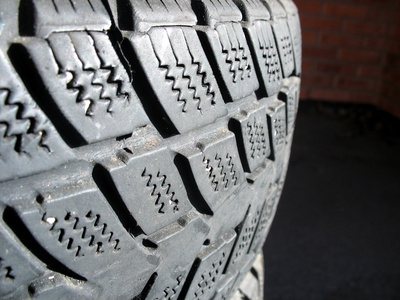
Studded tires first appeared around the turn of the 20th century to help automobiles gain more traction under icy and snowy conditions by way of small metal studs embedded into the outside surface of the tires. The United States began using studded tires in the 1960s. Improvements were made during the next two decades, and as of 2010, the studs are made of tungsten carbide in two different designs: the pin or tubular configuration.
You can purchase "studdable" tires without the studs mounted on them. Driving without the studs, however, can be less effective where conditions demand road-grabbing traction. When encountering heavy ice and snow, the studs can be inserted into the tire for immediate use. As long as the tire itself is in good condition, the switch can be made instantly and easily. Owners can opt to have two sets of tires--one set of standard road tires and another set of studded tires for winter conditions. Changing or adapting them takes little time and minimal cost.

Studded tires can increase cornering ability over heavy snow and ice. Vehicles equipped with the controlled-protrusion stud allows the studs (pins or tubes) to flex with the sideways torque and recover in their upright position. This no-side-slip feature while cornering gives the driver greater control.

Since the studs protrude from the tire shoulder and midline, they present added surface area to produce friction by grabbing and pushing material behind them. Studs typically measure 1.2 to 1.5 mm in length, providing more traction on grades and offering non-slip characteristics. Heavier passenger loads assist traction when climbing grades, because of deeper stud penetration.
The semi-rigid nature of the stud allows it to tolerate sudden load pressures, as those encountered with sudden braking or stopping maneuvers. Regular grooved tires can hydroplane over ice and snow, whereas with the studded tire, the weight of the vehicle allows the protruded studs to "bite," creating maximum friction.
Since road wear has been shown to be an unfortunate byproduct of studded tires, research has found that studded tires that travel over dense-graded HMA pavement--the most common U.S. road surface--actually produce less wear and grooving in the road surface, according to a 2002 Washington state Department of Transportation report.
In early 2008, the South Carolina company Q Tires announced a revolutionary studded tire that uses retractable studs that can be activated by a pushing a button on the dashboard. The retractable design allows for normal driving conditions on regular surface roads while including an instant profile change for severe winter conditions. Six states passed laws permitting the tires at the end of 2008, and marketing director of Q Tires, Sean Chariker, expressed hope for a near-future release.